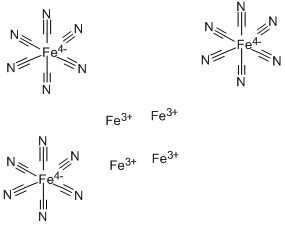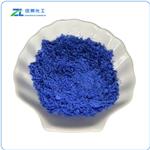Description
Iron blue is chemically referred to as ferric ammonium ferrocyanide Fe(Fe(CN)6)3. This material is generated through the reaction of sodium ferrocyanide and ferrous sulfate in the presence of ammonium sulfate. Pigments prepared with sodium or potassium salts are called ferric ferrocyanide.
Chemical Properties
dark blue crystalline powder
Uses
Iron(III) hexacyanoferrate(II) is uses extensively as an Iron Oxide dye. Prussian blue is used as a paint and wallpaper printing, chemical coatings, carbon paper and in the plastics industry. as an antidote for poisoning with radioactive cesium or thallium. In the metalworking and mechanical engineering Prussian blue is thinly applied as a paste on metal surfaces in order to assess the quality scraped surfaces can.
Uses
Prussian blue (KFe(Fe(CN)6)) is an intense reddish blue pigment with
fairly good properties. It is used as a coloring pigment in many types of
paint systems and is also used in the production of lead chrome greens.
Definition
The most common and best-
known name for blue iron ferrocyanide (iron blue)
pigments made by a variety of procedures.
Origin
Ferric hexacyanoferrate(II), known as Prussian blue, has the empirical formula Fe4[Fe(CN)6]3. It was probably synthesized for the first time by the paint maker Diesbach in Berlin in 1704, and it was one of the first synthetic pigments. A number of different, even if chemically related compounds, are named Prussian blue. Here this term refers only to insoluble ferric hexacyanoferrate(II)[1].
Flammability and Explosibility
Not classified
Structure and conformation
Prussian blue has a basic cubic structure consisting of alternating iron(II) and iron(III) located on a face centered cubic lattice, in such a way that the iron(III) ions are surrounded octahedrically by nitrogen atoms, and iron(II) ions are surrounded by carbon atoms[2].
References
[1] Crisponi, G. and V. Nurchi. “Chelating Agents as Therapeutic Compounds—Basic Principles.” Chelation Therapy in the Treatment of Metal Intoxication (2016) 35-61.
[2] Karyakin, A. “Chemical and biological sensors based on electroactive inorganic polycrystals.”Electrochemical Sensors, Biosensors and their Biomedical Applications (2008) 411-439.




